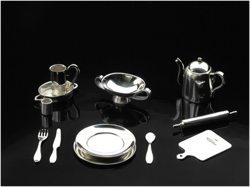 It is commonly believed that there is a price to pay for beauty. In the case of silver, this may be true. It is without a doubt one of the most lustrous, unique, versatile, beloved metals and extraordinarily popular for jewelry, household wares, and other forms of decorative art. By the same token, silver also happens to be one of the softest and most easily-tarnished of its gleaming cohorts, a fact which both increases its delicate attraction and makes it much more vital to care for properly.
It is commonly believed that there is a price to pay for beauty. In the case of silver, this may be true. It is without a doubt one of the most lustrous, unique, versatile, beloved metals and extraordinarily popular for jewelry, household wares, and other forms of decorative art. By the same token, silver also happens to be one of the softest and most easily-tarnished of its gleaming cohorts, a fact which both increases its delicate attraction and makes it much more vital to care for properly.
When dealing with such an exquisite material, one must learn to take good care of it in order to be worthy of its glow. That said, cleaning your silver items isn’t a difficult undertaking, simply one that should be paid attention to in order to avoid corrosion. There are several different recommended ways to clean this metal, depending mainly on the particular objects and their uses.
Certain materials, like rubber, stainless steel, and sulfur, work to tarnish silver and should be avoided during the cleaning process. Therefore, washing silverware alongside other dishes is highly cautioned, particularly utensils made of other metals and materials that can scratch and corrode, like stainless steel. Instead of rubber gloves, use gloves made of a synthetic material like nitrile and a soft cloth or towel in place of abrasive sponges or scouring pads, which can cause scuffs and scratches. Don’t let the silverware sit out to dry; use a soft towel to dry off the moisture, and if the utensils are dull, a cotton cloth can be used to return them to a glossy sheen.
When silver flatware or silver jewelry begin to show signs of tarnish, the problem should be tackled early on to avoid more severe ones. Many people prefer to use one of the many silver polishing products on the market, particularly for more valuable pieces, as these are specially formulated to clean silver without damaging it. However, common materials around the house can also be utilized to save money for less valued items. Some of these include baking soda made into a paste with warm water, plain white toothpaste (without any whitening agents), a hot salt water/aluminum foil bath, or even 7-Up. While these methods save money and chemical risks, be aware that they are not guaranteed to be as effective and may cause some damage to the silver.
Whether you fancy these household techniques or gravitate towards specialized cleaners, it is important to use only soft, harmless materials for the process. Cotton balls, cotton cloth, soft towels, soft cellulose sponges, and Q-tips (for grooves and hard-to-reach spots) are recommended as they won’t cause harm to silver. Also, make sure your silver is completely dry before wrapping it in flannel or tissue and storing it away from humidity and any materials that can corrode it, preferably in an airtight bag. Silver is a gorgeous material that begs to be showed off. Taking these steps to clean, polish and protect it will ensure that you keep your silver looking flawless.
But if you just can’t get your silver to shine like it once did, make quick cash by selling it to CashForSilverUSA. CashForSilverUSA accepts your old, tarnished, broken, and tangled silver wares and awards you generously for them. Contact CashForSilverUSA today!

Leave A Comment
You must be logged in to post a comment.